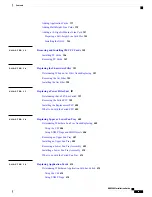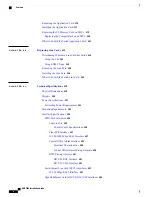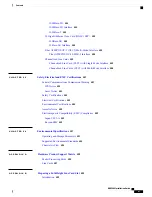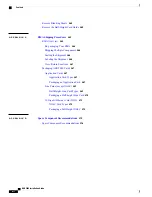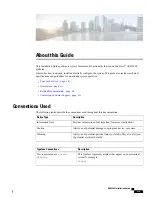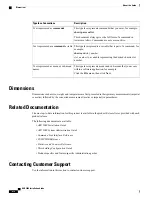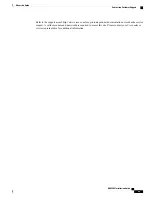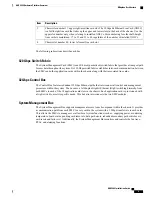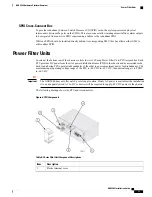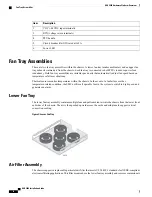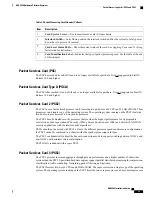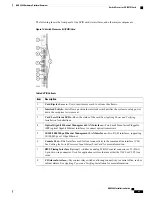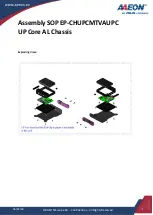
Slot Number
Position
33
34
35
36
37
38
39
40
41
42
43
44
45
46
47
48
Rear
Bottom
Slots
Rear Slot Numbering for Half-Height Line Cards
Rear-installed line cards must be installed directly behind their respective front-loaded application card. For
example, an application card in Slot 1 must have a corresponding line card in Slot 17. The redundant line card
for this configuration would be placed in Slot 33. This establishes a directly mapped communication path
through the chassis midplane between the application and line cards.
To help identify which rear slot corresponds with the front-loaded application card, the upper rear slot numbers
are equal to the slot number of the front-loaded card plus 16. For example, to insert a line card to support an
application card installed in slot 1, add 16 to the slot number of the front-loaded application card (Slot 1 + 16
slots = Slot 17). Slot 17 is the upper right-most slot on the rear of the chassis, directly behind Slot 1.
For lower rear slot numbers, add 32. Again, a redundant line card for an application card in Slot 1 would be
(Slot 1 + 32 = Slot 33). Slot 33 is the lower right-most slot on the rear of the chassis, also behind Slot 1.
Rear Slot Numbering with Full-height Line Cards
ASR 5000 systems may be configured with 10 Gigabit Ethernet Line Cards (XGLCs). These are full-height
line cards that require the removal of the half-height card guides to accommodate the cards. In this case, only
the upper slot number is used to refer to the XGLC. For half-height cards installed with the XGLCs, the
half-height slot numbering scheme is maintained.
For example, XGLCs installed in slots 17 and 32 also take up slots 33 and 48, but are referred to as cards in
slots 17 and 32 only. The slots in which the SPIOs and RCCs are installed in the same configuration, are slots
24 and 25, and 40 and 41, respectively.
Mounting Options
The chassis is designed for installation in a standard (EIA-310-D, IEC 60297) 19-inch wide (482.6 mm)
equipment rack or telco cabinet. Additional rack hardware (such as extension brackets) may be used to install
the chassis in a 23-inch (584.2 mm) rack. Each chassis is 24.50 inches (62.23 cm) high. This equates to 14
Rack Units (1 RU = 1.75 in. [44.5 mm]).
You can mount a maximum of three ASR 5000 chassis in a 2- or 4-post equipment rack, or telco cabinet,
provided that all system cooling and ventilation requirements are met. Three stacked chassis will occupy a
minimum of 42 RUs.
There are two options for mounting the chassis in an equipment rack or telco cabinet:
•
Flush mount
: In this configuration, the flanges of the mounting brackets are flush with the front of the
chassis. This method is typically used with 4-post racks and telco equipment cabinets. This is the default
configuration as shipped.
ASR 5000 Installation Guide
7
ASR 5000 Hardware Platform Overview
Mounting Options
Summary of Contents for ASR 5000
Page 16: ...ASR 5000 Installation Guide xvi About this Guide Contacting Customer Support ...
Page 64: ...ASR 5000 Installation Guide 48 Installation Procedure Overview Laser Notice ...
Page 100: ...ASR 5000 Installation Guide 84 Line Card Installation Installing the XGLC ...
Page 122: ...ASR 5000 Installation Guide 106 Cabling the Fast Ethernet 10 100 Line Card FLC2 Interfaces ...
Page 206: ...ASR 5000 Installation Guide 190 Removing and Installing SMC PC Cards Removing PC Cards ...
Page 212: ...ASR 5000 Installation Guide 196 Replacing the Chassis Air Filter Installing the Air Filter ...
Page 220: ...ASR 5000 Installation Guide 204 Replacing a Power Filter Unit What to do with the Failed PFU ...
Page 266: ...ASR 5000 Installation Guide 250 Safety Electrical and EMC Certifications Korean EMC ...
Page 270: ...ASR 5000 Installation Guide 254 Environmental Specifications Chassis Air Flow ...

